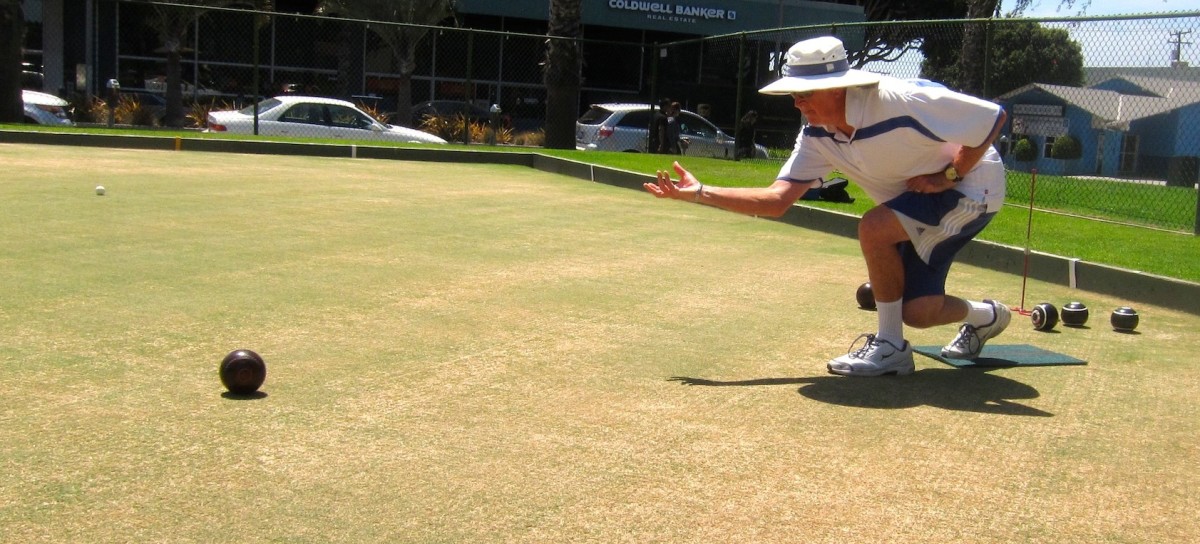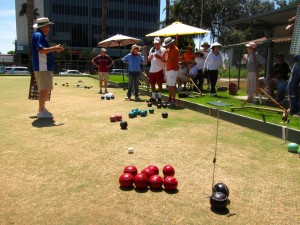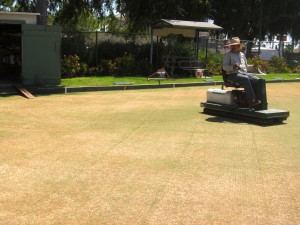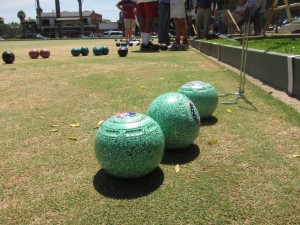
The Santa Monica Lawn Bowls Club has been hiding in plain sight for more than seven decades. Most likely you’ve passed by the club’s lifeblood many times, the expanse of enclosed green lawn at the southern edge of Douglas Park along Wilshire Boulevard.
You may have even spotted club members engaged in rolling their bowls along the length of the grassy field in slow, precise movements.

Many people are even curious about this ancient game of bowls, but too often that curiosity doesn’t translate into taking that initial step and walking into the club and asking for a first lesson, a request that members would gladly oblige.
Longtime Santa Monica resident Dixie Vanderloop was one of those people who was intrigued for many years by the prospect of lawn bowling but never ventured in.
“I drove by it for about 10 years,” she said. “One day the club president was out here and I stopped in and he gave me a lesson and I came back the following Monday.”
That was 11 years ago. She’s been coming three days a week ever since and is now the club’s vice president.
“I like the competition. I’m competitive. I like to win, but I don’t mind losing if I’ve played a good game,” Vanderloop says.
The Santa Monica club currently has 75 members, a typical number for the group. Most members are retirees, as is true for other clubs in America, although Santa Monica has one member who is 14 years old. Dues are a sweet deal as adults pay only $125 in annual fees, which entitles them to play up to four times a week year-round.
[pullquote align=right]
“[People] come, bowl a game and be social and meet with friends. But there is a hardcore minority group who are fiercely competitive.”
[/pullquote]The club has been located at Douglas Park since 1948. The playing field is precisely manicured Bermuda grass planted in a foot-and-a-half of sand. The field was destroyed by heavy rains in 1982 and then rebuilt.
“I like to think of it as a billiard table with grass. It is laser-leveled, absolutely flat and smooth,” says club president Brian Studwell, with a certain amount of pride.
Studwell’s entrance into lawn bowling is somewhat typical. He first tried it about 20 years ago when he had to give up skiing and tennis for medical reasons.
“A friend of mine bugged me for months and finally I said, ‘Ok, I’ll come down and take a lesson just to get you off my back,’” he said. “I was hooked after my first lesson.”
In America, lawn bowling is a game often discovered like that later in life. But in other countries, such as Australia, it is heavily promoted among younger people. There is an international organization known as World Bowls that holds tournaments, as well as regional and national groups in the U.S. including Bowls USA.

Santa Monica resident Phil Dunn took up the game eight years ago and has quickly developed a highly skilled game. He has competed as a member of Team USA and played in eight different international tournaments. He enjoys the competition, but comes out regularly to Douglas Park for reasons other than to add to his trophy collection.
“It’s like meditating. I’m out here in the beautiful park, beautiful setting, beautiful trees,” he says. “The second thing I like is that people are very friendly.”
Studwell says that the majority of lawn bowlers in America are in it for social reasons.
“They come, bowl a game and be social and meet with friends,” he says. “But there is a hardcore minority group who are fiercely competitive.”
Studwell believes that younger people would enjoy the competition and social aspects of the sport. But getting them to join the club has been challenging. The club is open four days a week on Monday, Wednesday, Friday and Sunday, but only during midday, since that is the traditional time for this ancient sport, which dates back thousands of centuries.
Those hours make it difficult for school kids and working adults to participate.

Lawn bowling is a very simple game to begin playing. Players use bowls, which are balls with two flat sides, and roll them toward a target known as a jack. Depending on how many players are involved, each player may roll between two and four bowls during a turn. Points are scored for every bowl a team can place closer to the jack than the best bowl of an opposing team.
On days when the club is open, members drop by and then teams are assembled based on the ability of the players who are there. About 30 members showed up on a recent Wednesday at noon. Matches typically take more than two hours.
“It’s an easy game to learn,” Studwell says, and then pauses for effect. “But it’s a hard game to master.”

Comments are closed.